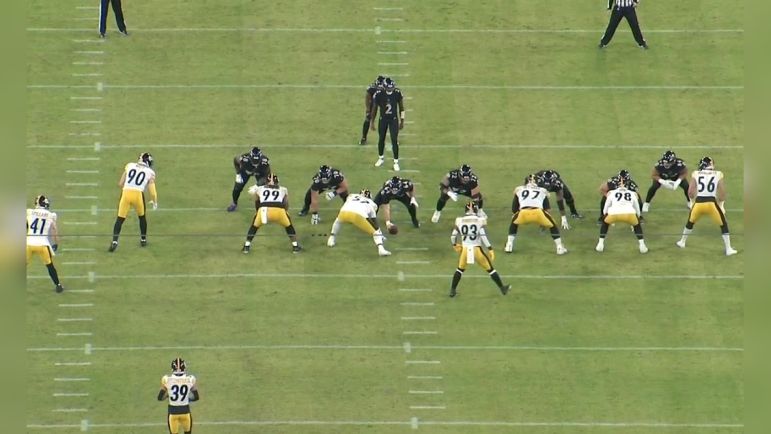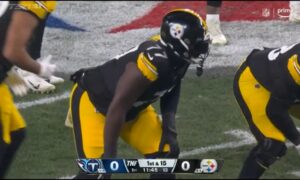The Steelers’ defense got gashed on the ground in their Week 14 home matchup vs Baltimore. Facing a rematch with their season on the line in a Week 17, Sunday Night road contest, the Steelers coaching staff was forced to get creative to find solutions against one of the league’s most potent rushing attacks. While Kenny Pickett’s masterful game-winning drive will draw most of the attention, and deservedly so, Mike Tomlin, Teryl Austin, Brian Flores, and the rest of the Steelers’ defensive coaching staff deserve massive credit for their creative game plan this past weekend.
In total, Pittsburgh limited Baltimore to just 240 total yards, netting 13 points and 15 total first downs. They were able to outgain the Ravens on the ground 198 yards to 120, simultaneously holding Tyler Huntley to a pedestrian 14-21 passing for 130 yards with one touchdown and a Minkah Fitzpatrick interception which sealed the game. Through achieving key stops in short yardage situations, where they failed repeatedly in Week 14, Pittsburgh’s defense was able to help Pickett and the Steelers run game control the clock, en route to a lopsided 34:14 to 25:46 time of possession figure in their advantage.
So how was Pittsburgh able to piece together a much improved defensive performance on the road? The answer centers around a creative game plan which featured a variety of heavy personnel packages on defense, essentially forcing the Ravens to beat them with Huntley’s arm. Per our own Alex Kozora’s defensive charting, the Steelers deployed a 4-4 package, which they first showed against the Panthers, on roughly 52% of their total defensive snaps, a figure which shows their commitment to the run game.
Outside of the 4-4, Pittsburgh also ran the base 3-4 on just 11% of their defensive snaps, essentially opting to make the 4-4 their base defense on run downs and short yardage situations. Finally Pittsburgh rounded things out with some sub-package usage, the bread and butter of their defense, deploying Nickel on 11% of their defensive snaps and Dime on about 26% of their defensive snaps, including Baltimore’s entire six-play drive following Pickett’s scramble drill touchdown.
As for the personnel in Pittsburgh’s 4-4 package, they deployed four down defensive linemen, four linebackers (two edge rushers and two off-ball inside linebackers), and three defensive backs (two safeties and a cornerback). As for player personnel, the team began the game with Montravius Adams, Larry Ogunjobi, Cam Heyward, and DeMarvin Leal as the four down linemen. Both edges, T.J. Watt and Alex Highsmith were on the field as well, with Robert Spillane and Mark Robinson, playing in favor of Devin Bush, as the two off-ball linebackers.
Thus, although the defense fielded two standup edge players, it functions more as a 6-2 in nature than a true 4-4 seen at various levels of high school football. As for the secondary, Minkah Fitzpatrick lined up as the post safety on most snaps, with Cam Sutton as the single corner on the field, and Terrell Edmunds serving as the “cornerback” to the tight end side of the formation. With the Ravens operating out of plenty of 13 personnel, Pittsburgh was able to effectively remove a cornerback, as they remain comfortable with Edmunds’ ability to man up tight ends.
Another vital piece of Pittsburgh’s ability to play heavy personnel in this game was their growing trust in Robert Spillane, and his ability to execute all necessary assignments. In their 4-4 package, he served as their primary adjuster out of the box, taking man coverage assignments on tight ends in the slot and running backs split out wide to keep Mark Robinson in the box at all times.
As for Robinson, he certainly impressed in his first extensive defensive action for Pittsburgh, showing the necessary physicality and finishing the game with seven tackles. Playing directly over the center on the game’s first snap, Robinson initially follows motion before diagnosing the guard pull, planting to flow down the line, and snapping his hips through on contact to plant J.K. Dobbins with a physical stick. His raw movement skills and change of direction ability are intriguing, to say the least. Credit to Terrell Edmunds for meeting the puller with solid physicality to keep Robinson free and force Dobbins inside to his help.
Similarly interesting was their usage of DeMarvin Leal who was frequently aligned head-up on Patrick Ricard, where he would have the Ravens fullback in man coverage on passing assignments. Through crowding the box, and keeping a body on Ricard at all times, the Steelers were able to limit his effectiveness as a puller, a possibility made viable through Leal’s unique athleticism for a tweener defensive lineman.
With Pittsburgh once again in their 4-4 defense, Leal is aligned head-up on Patrick Ricard in a two-point stance. At the snap, Leal runs with Ricard in motion before diagnosing opposite guard pull, planting and redirecting back to his left, and arriving to combine with Mark Robinson and T.J. Watt for no gain. As for Watt, he is able to follow Ricard’s motion off the edge, piercing into the backfield to shorten the edge before getting skinny to slit past the pulling guard, contorting his body to finish with a “peanut punch”.
Checking back in with Mark Robinson, once again aligned over the center, playing from depth, Robinson reads guard pull, stepping up to fill the C-gap and knives under the pulling backside tackle to get involved in the action. Early in the game, Pittsburgh’s mission was evident, keep Baltimore behind the chains on early run downs and force them into 3rd and long situations, where Huntley would be forced to beat them through the air. By simply putting more bodies into the box and on the line of scrimmage, Pittsburgh was routinely able to muddy holes in the Ravens’ run game, a gap-heavy scheme that centers around creating extra gaps through the use of misdirection and multiple pullers on most snaps.
Robert Spillane may have had his best game as a Steeler, finishing with a game-leading nine tackles, eight of which came via the solo variety, including an impressive tackle for a loss on a tight end screen to Isaiah Likely. Early in the game, the Steelers placed seven defenders crowding the line of scrimmage, including Mark Robinson aligned tight to the field side A-gap, with Spillane playing from depth alongside Terrell Edmunds.
At the snap, Spillane flows down the line after diagnosing outside-zone, showing impressive hand usage to extend and defeat a block from Josh Oliver, and finishing with a nice stick, stringing out the play for a short gain. He routinely showed great ability to diagnose plays, react quickly, and shed blocks to keep himself clean all night.
Run defense is often talked about to be an 11-man job, needing every defensive player, including cornerbacks at times, to get involved in shutting down the league’s premier rushing attack. With the Steelers once again in their 4-4 defense, with all four linemen and both edges crowding the line of scrimmage, the Ravens bring Ricard in motion on a crack/toss play.
Leal does a great job of generating knockback and flowing down the line of scrimmage to string the play out. While Ricard does a solid job of sealing Alex Highsmith upfield on a double team, Sutton reads Dobbins cutting outside, doing a great job to get skinny, slipping under the block, and combining with Leal to drop the back for a short gain. Crack/toss plays are designed to make cornerbacks tackle running backs in space, and Cam Sutton undoubtedly answered the call here, slipping a block from arguably the best fullback in the league.
Pittsburgh’s defensive strategy was centered around the goal of forcing the Ravens into obvious passing situations, where their lackluster receiving core was unable to threaten the Steelers’ secondary. Merely one player later, forcing the Ravens into a 2nd and 8, Pittsburgh downsizes back into their traditional 3-4 base package, sitting in a Cover 1 man defense to counter the Ravens 02 personnel.
At the snap, Sutton sits at eight yards depth vs Demarcus Robinson, playing with outside leverage vs the receiver’s cut-split alignment. As Robinson releases upfield, Sutton patiently pedals, staying square before opening to match the receiver’s break toward the sideline. As Robinson slips as he breaks back inside on the pivot route, Huntley releases an errant throw amidst pressure, with Sutton nearly securing a diving interception.
With so many bodies crowding the line of scrimmage in the Steelers’ 4-4 look, Baltimore consistently struggled to get the edge, with too many bodies flowing down the line of scrimmage. Once again operating with 13 personnel in the red zone, attempts to run a jet sweep, with both Gus Edwards and the backside guard pulling to function as lead blockers.
While Mark Robinson gets blown up at the point of contact, his speed to meet Edwards in the backfield forces the receiver to bounce the run outside, where Terrell Edmunds is able to fill off the edge from his cornerback spot to stop the receivers progress, allowing Spillane and Highsmith to finish the play with elite backside pursuit. While it doesn’t show up on the stat sheet, I love Robinson’s trigger here. He trusts what his eyes see, and arrives downhill with bad intentions consistently.
Following the Steelers’ 15-play drive to open the game, the Ravens were able to respond with a 15-play drive of their own. Notably, both drives ended in field goals. With the Ravens threatening deep in the Red Zone, Pittsburgh was able to force a 3rd and 5, putting their Nickel defense onto the field, with press coverage across the board.
On the crucial down, Pittsburgh once again opted to use a Cover 1 look, with Minkah Fitzpatrick and Myles Jack as the free players. Pittsburgh locked up across the board, with Cam Sutton clamping down a Demarcus Robinson “whip” route, Minkah Fitzpatrick coming down to clamp a shallow crosser, Edmunds disrupting Mark Andrews with physicality, and Arthur Maulet staying in Desean Jackson’s back pocket to ensure an incompletion. While the Ravens receiving core lacks star power, Maulet has made plays in coverage in recent weeks. Still by no means a coverage player, the more he is able to survive matchups in the slot, the more Pittsburgh can use their Nickel package on early downs moving forward.
It is no secret that the Pittsburgh defense has improved mightily since getting reigning NFL defensive player of the year T.J. Watt back from an early season injury. Early in Sunday Night’s game, Watt played games with Ravens Pat Ricard, evading his blocks with pure speed. Here, as Ricard flows across the line of scrimmage to execute a kick-out block on the split zone play, Watt triggers hard at the snap, flying right past the fullback to hit Gus Edwards in the backfield, leaving an unblocked Mark Robinson to make a nice tackle after a short gain. It doesn’t need to be said, but Watt makes two to three plays every single game that simply makes your jaw drop, his body control is off the charts.
Pittsburgh’s defensive personnel as a whole deserves plenty of credit for their performance Sunday Night, but acknowledgments simply need to be made for the game-planning done by Tomlin, Austin, Flores, and the rest of the defensive coaching staff. All season, Pittsburgh has been great at executing difficult post-snap rotations in the secondary to confuse opposing quarterbacks, but from a schematic perspective, the coaching staff’s creativity and open-mindedness to adapt and try something new after getting gashed in Week 14 deserves plenty of credit.
With the season seemingly dead at 2-6 and later, 3-7, Pittsburgh has rebounded to 8-8, improving greatly on both sides of the ball after the bye week, and has a realistic shot at making the playoffs as the 7th seed. While any success beyond that remains unlikely, this team, with a successful ground game and a better defense than what was shown last season, has a better chance of producing a potential playoff upset than last year’s anemic offense.
All things considered, it’s hard not to be excited about where this team could be heading into next season, with a potential franchise guy at quarterback, an effective two-headed rushing attack, an improved offensive line, and more importantly than anything, a sense of identity on the offensive side of the ball for the first time since 2017. While improvements can and will be made on the defensive line and at the off-ball linebacker position, hopes are high that the Steelers’ second half of this season sets them up for future success.








